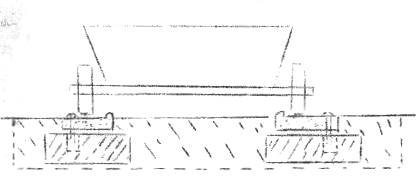History of
Quarrying - Report on the Penrhyn Tramroad by T. Dadford and Son
Copy
Report on a Conveyance of Slate from the Quarries (Penrhyn) Bethesda, to Port
Penrhyn.
June 5th 1800 by T. Dadford & Son
We have surveyed and examined the country for a Canal and a Railway and found it
very unfavourable for the former, owing to the great and irregular falls of the
ground, and it would require a mile of locks and Incline Plane to pass the boats
from one Canal to the other. The expense of making it would be very considerable
and the carriage would not be done on it for less money than by rail.
The country is not so forbidding to a railway and will admit one as convenient
as most places, which we recommend to be as follows, beginning from the present
quarry and going Northwards Two Miles and Five Furlongs with a fall of 8 inches
in a Chain (Twenty-two yards). Then to descend by an Incline Plane 142 yards
long and fall 63 feet (5.3/10 inches in yard). From thence the road to continue
Three Quarters of a Mile with a like fall of 8 inches in a chain and descend. An
incline plane of 220 yards in length, 58 feet fall (3.1/10 indies in Yard). From
thence continue the road Seven Furlongs falling 8 inches in a chain and then
descend by a third incline 550 yards long, Falling 102 feet (3.7/10 inches in a
yard), and from thence go to Port Penrhyn and Shipping Place. Making in the
whole Six Miles, Six Furlongs and a fall of 558 feet. For the line refer to
plan.

PENRHYN TRAMP
T. Dadford and Son.
The Road to be as follows. Six yards wide and covered with gravel or broken
stones Three Yards wide and Nine inches thick, on which place blocks of dtone
nearly one Cwt with circular hole drilled in the middle 6 inches deep and 1½
inches diam; into which drive a wood pin to receive a nail for fastening the
rails, after which the road to be raised with gravel &c. well rammed around
the blocks (see section). The rails to be made one Yard in length to the Tram
Rail plan with flanges and to weigh 40 Ibs. each, which will be 80 Ibs to the
yard and 6 tons to the mile, On this road wagons with iron wheels properley
constructed carrying from 50 Cwt to 2 Tons each, and a tolerable horse will take
6 or more of them with ease and return with the empty ones carrying 2 to 5 tons.
The incline planes to be on the Rotative principle or endless chain, working by
a wheel at top and bottom and a double railroad for the loaded waggons coming
down and the empty ones going up; by this means Slates will be taken down at
about 7d. per ton, and from one to two hundred tons per day,
|
ESTIMATE |
|
|
|
| To- forming stoning &c the Road 11066 yards at 2/6 yd |
1383 |
3 |
0 |
|
Do |
Do |
Incline Planes 692 yds at 4/- |
|
138 |
2 |
0 |
| 24902 Blocks-Stone, Nails etc @ 8d 830 |
830 |
0 |
0 |
| 457 Tone of Cast Rails @ £11 ton 5027 |
5027 |
0 |
0 |
| Laying down the rails 150 |
150 |
0 |
0 |
| Bridges waterways &c 150 |
150 |
0 |
0 |
| Wheels, chains &c for incline planes 500 |
300 |
0 |
0 |
|
|
|
7978 |
5 |
0 |
| Contingencies &c |
350 |
0 |
0 |
|
|
|
8328 |
5 |
0 |
Ref: XM7004/5
Report on a Conveyance of Slate from the Quarries (Penrhyn)
Bethesda, to Port Penrhyn
|